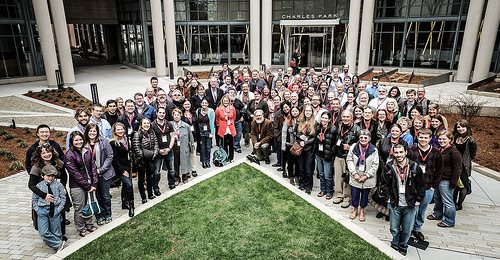
Personal Genome Project © PersonalGenomes.org [flickr.com/personalgenomes]. License https://creativecommons.org/licenses/by/2.0/
A growing community of Chinese medicine scholars? Probably not, but…
But our bodies have innate intelligence, and much of our internal processes happen without our awareness. Such is the case with cellular repair. This occurs automatically, the instructions for which are coded in our DNA.
However, the repair process does not always occur as usual—evidenced by the existence of disease, wherein we are unable to repair damage from failing to adapt to noxious triggers. This breakdown may be that the offensive variable overwhelmed our adaptive capabilities, or that our DNA has mutated and thus lost the program for a specific repair sequence.
If the DNA program for cell death is damaged, then a mutated cell can continue to divide and spread, leading to cancer.
Chinese Medicine Context
The above concepts are encompassed by yin-yang theory—the basis of acupuncture and Chinese medicine. Yin and yang represent opposite extremes of any given variable. The following exemplifies the variables above, in yin-yang context.
Physical attributes: Hard (yang)—Soft (yin)
Chemical attributes [pH balance]: Acidic (yang)—Alkaline (yin)
Thermal attributes: Hot (yang)—Cold (yin)
Our bodies are dynamic. Our hidden processes are constantly shifting between two opposing thresholds in order to maintain balance. To counteract a disease process, Chinese medicine first determines its nature. It is a conceptualization of the person’s inability to adapt to changes within the spectrum of two extremes. This is called pattern differentiation, where yin and yang represent the broadest categories. However, in clinical practice, further differentiation is typically required.
Refined pattern differentiation includes a consideration of:
-
- Qi, blood and fluids (i.e. whether the problem is functional or structural)
- Acupuncture channels (i.e. whether the problem involves the vital or sensory organs, or other outer layers of the body)
- “Five phases” (i.e. whether the dynamic relationship among any of the physiological systems is disrupted)
The final pattern differentiation becomes the principle of treatment.
These Chinese medicine terms may seem overly abstract to many Westerners, yet they provide a framework to accurately assess an individual’s condition and to predict the outcome (with or without treatment) with a fair level of probability.
While yin-yang theory often eludes Western comprehension, ironically genomics is beginning to embody a Chinese medicine approach to pattern differentiation.
Genomic Development
In the early days of human genome sequencing, it was thought that science had finally articulated the nature of disease. Over the next decade(s), the excitement was tempered by the sheer complexity of the inner self.
It is not enough to simply identify genes. We still need to understand how these genes are activated. For the existence of a mutated gene does not guarantee disease—a premise that is addressed by the field of epigenetics.
Promisingly, a recent genomic development is channeling Chinese medicine thought. It invigorates my hopes for truly integrative medicine.
A recent analysis of tumor cell DNA has calibrated Western science to an Eastern mode of pattern differentiation. The researchers endeavored to differentiate patterns of mutation to “cluster breast cancers into different types.”
From the Economist, on the genetic study:
“In essence, even though their symptoms are similar, these groups are different diseases.”
Compare that to the Chinese medicine adage:
“One disease, many symptoms. One symptom, many diseases.”
The “five phases” presents the final stage of pattern differentiation in Chinese medicine. It accounts for the dynamic interrelationship between biological systems. Meanwhile, genomics is furthering its understanding of the dynamics of gene expression, and is thankfully not content with the static identification of a gene. Though Western science may never adopt Chinese medicine theory, there is correspondence between the two.
Carl is a former engineer who applies rational thought to the often subjective nature of traditional healing. He practices acupuncture in San Diego, CA.
